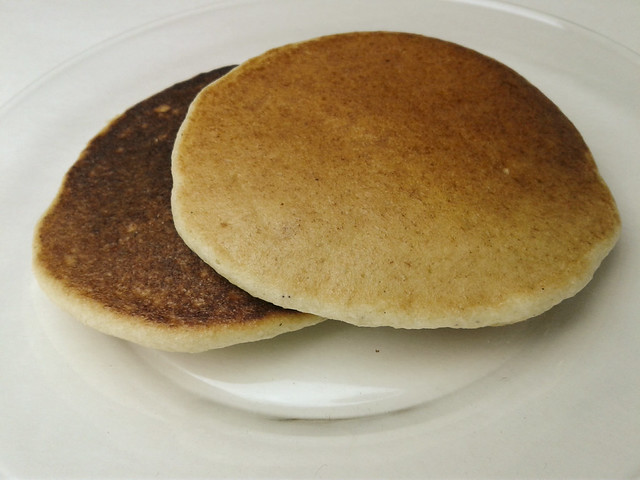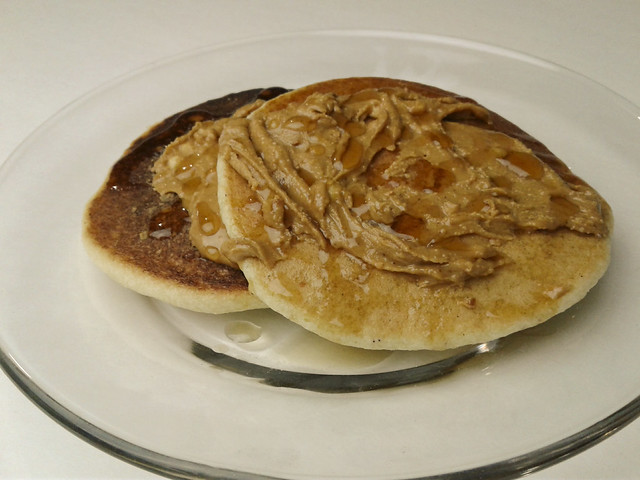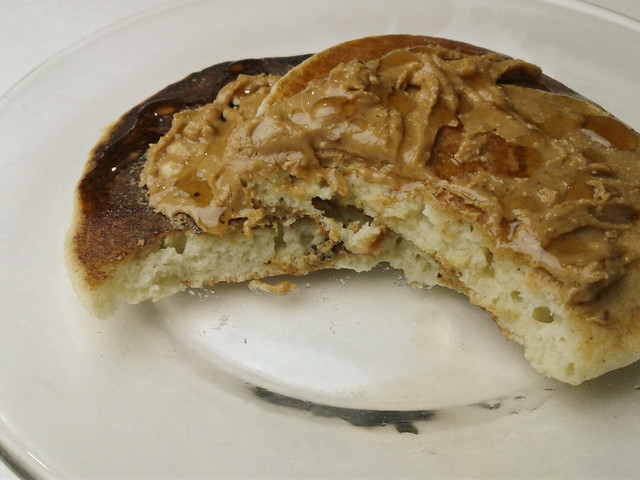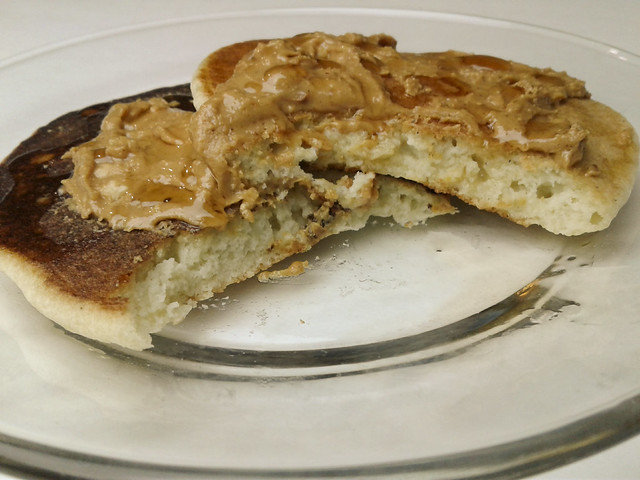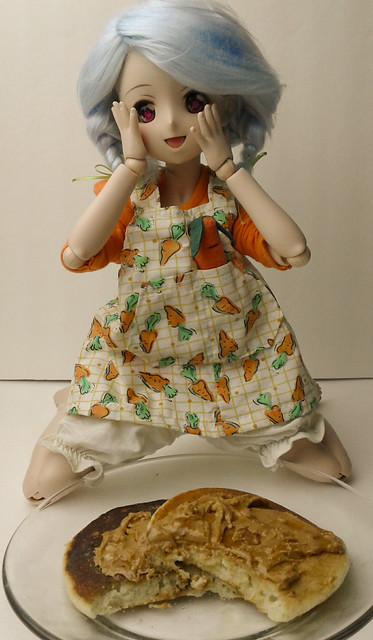This morning I was expecting to fail. I have been baking and cooking since I was in grade school and there was one thing I distinctly learned: For fluffy baked goods using baking soda, baking powder, or yeast was a requirement. Without it you get nothing but a flat mess and a huge disappointment. To say the least, the discovery that I’m deathly allergic to baking soda after eating it my whole life has been far from the easiest food restriction to adapt to.
Now that isn’t to say I’ve never had an issue with baking soda, but in fact I’ve had a mostly hate relationship with it since I could identify the taste of it in baked goods. Especially in pancakes. It took me a few years after I was married to finally find a pancake recipe that didn’t taste horrid or give me a massive stomach ache due to a heavy amount of baking soda used to make it fluffy. By contrast, I loved baking powder because it did the same thing, tasted MUCH better, and would not upset my stomach. And then there was the fact that we ate a lot of baking powder biscuits with diced up wafer lunch meat (always the super cheap and salty Carl Buddig brand), peas, and white sauce for dinner when my mom was going to college.
So lo and behold, I could not have been more shocked when half way through my 38th year when my intolerance to anything corn or corn derived finally caused me to test out homemade baking powder in gluten-free tortillas. I thought that I could learn to tolerate the severe stomach upset it always caused me because I had no idea how to cook without it. It only used a small amount so I didn’t think it would be that bad.
It was that bad, and worse.
When I had to remove wheat and oats from our kitchen, I thought I’d never be able to have proper pancakes ever again. My mother-in-law had always made Danish Pancakes (essentially crepes eaten with different toppings) as my husband was growing up and those weren’t hard at all to convert. But this paper thin, ghostly resemblance was not and could never pretend to be a good old-fashioned pancake. Growing up in a farming community still heavily rooted in it’s pioneer heritage, I’ve always have had a love of pancakes.
Flapjacks. Griddle cakes. Hotcakes. Flatbread. Turtle blankets*. Whatever you call them they are wonderful enough to have their own holiday, and even Wikipedia entry.
I just knew it was just a good old down home cooking. Have a stack of them topped with butter and maple syrup, along side scrambled eggs and greasy meat or meat replacement and that’s a fine way to start the morning before heading out to take care of the livestock or hacking down some trees in the woods like Paul Bunyan.
Crepes/Danish pancakes are good but look more like something that would be used to drape on a cake to make it look like lacy fabric. Not really anything to go out of your way to eat. I guess they don’t do too badly as a banana wrap with creamy peanut butter and maple syrup. At least you don’t need to eat a dozen of them that way before you are full.
And waffles never even had a chance to compare in my book. I’m boggled by Belgian waffles despite that my husband adores them. They are just a very confused, yet structurally sound, strawberry shortcake. At least if it is topped in uber sugary strawberries and whipped cream. Waffles should be for cones. Seriously, I have only ever seen them as a fat edible dish to dump dessert on and somehow make it acceptable to eat for breakfast. The only difference between a raised doughnut and a waffle is that the waffle looks stomped on.
Move over partner. This town ain’t big enough for the likes of you. Sheriff Pancake is going to ride you and all of your flippery out on the next train. This here be a one plate town, and there’s no fork for you.
Hmm? Exaggeration you say? No, as a kid I just didn’t like being told not to play with my food, so I just made up stories in my head when I ate. Nothing weird about it. ;D
So the notion that I could never have actual pancakes again was emotionally devastating. One year for my birthday all I wanted for breakfast was pancakes cooked in a cast iron skillet in a thin lake of oil (it gives the pancakes a crispy ring around the edge that I loved as a kid), sunny side up eggs, and some vegan bacon. I can live without cold cereal. Someone else can eat my cinnamon rolls. And even blueberry muffins can be left on the table. Just don’t take away my pancakes.
After a night of not sleeping well, getting frustrated over trying to figure out what food to test next only to find out I’m feeling sick yet again, I was mentally and emotionally exhausted. It was nearing breakfast time and all I wanted was pancakes. Without baking soda or baking powder it would just be a rubbery round slab, but not really a pillowy pancake. The kind of pancake that a maple tree would hope it’s sap would be savored with.
The only point of reference I had that gave me any clue on how to make salvageable pancakes was the experience I’ve had over the years of making my grandmother’s chiffon cake. But even that has baking powder. So simply by association I thought the whipped egg whites would only work because of the baking soda.
But I was mad at having to keep on telling myself that I was going to have to learn to like Danish pancakes as the ‘best’ replacement for real pancakes. (Don’t get me wrong, I really do like danish pancakes a lot. They are just two completely different things. They are as similar as lasagna and pizza. Both have cheese, tomato sauce, veggies, protein, olives, and a traditionally wheat component in it with the crust or noodles, but one is not the replacement for the other even if both are tasty.)
On this particular morning, the rationalization that I’d have to ‘make do’ was just not good enough. I felt like a cranky little kid who just wanted some darn pancakes. Being OCD it is hard to hit a point where I just don’t care if I screw up and completely fail. After having so many foods that I love taken away probably forever the last seven months, I got so mad I was about ready to start yelling at the top of my lungs as I marched into the kitchen.
Gosh darn tarnation! I was going to have something that resembled a pancake if I had to beat those egg whites within an inch of their life! I was not going to be hogtied by something so trivial. Not when the fate of pancakes was on the line!
The result was something I never expected. I was floored.
As the first trio of cakes cooked in the skillet, and didn’t instantly deflate, I kept waiting for when they would eventually fall. I’ve baked plenty of cakes from scratch so I knew that it takes very little for it to happen sometimes. Sure they looked poofy now but once they were flipped all hope would be lost.
With a sigh the first pancake was flipped.
To say the least I was delighted to see that it looked just like these pancakes should! The moments passed and my pillowy cake didn’t deflate like some old tire. I was astounded. Especially with the whipped egg whites that they were about twice as poofy as the same recipe with baking powder and not whipping the egg whites. Still, I was waiting for the moment of the inevitable failure.
Would they even be cooked all the way through? Or would they still be gummy for some unknown reason? I have just experienced so much heartache and disappointment with foods these last few months that I continue to expect everything to be a fail unless it is eaten out of the produce department.
For many years I have had the habit of eating the first pancake either by taking a big bite out of it right away with noting added to it or ripping it in half to see what the insides look like. My hopeful little cake was so hot that I could barely hold onto it, Like a hungry animal I promptly ripped it in two, angling it so it partially ripped off the cooked surface, revealing the interior bubble structure like cut honeycomb.
It was a relief to see the guts of my pancake look just like they should. At last I took my first bite.
And it was perfect.
Well, perfect enough to make me blissfully smile. All the important parts were just right, mainly the texture and the ‘bready’ feel. Just for me personally I think next time I will reduce the sugar to 2 tsp. because I don’t like my pancakes being sweet. I want to use the same recipe for breakfast pancakes with syrup and apple sauce as I do for dinner pancakes with veggies and peppered white sauce.
I guess I could have called these “Bare Bones Pancakes” but I didn’t. These would be dazzling if you wanted to increase the sugar and add vanilla or even some lemon zest. They should hold up just perfectly fine if you want to swap the sugar for any other powdered sugar replacement, but if you use liquid sweetener you may take the extra liquid amount out of the water measurement. Or replace the water with non-dairy milk. Or increase the liquids by 1-2 TBS. to thin the batter if you want them thinner. Another whipped egg white might add even more loft, but I’m not sure how far that boundary can be pushed without further testing.
This is the brilliance of pancakes. They are so versatile. We have often used them in the past as hamburger buns or just slices of bread. They also freeze perfectly. We have been known to eat them with pudding on top. Not sure if I can do that anymore but it was yummy!
Just make sure you don’t get too excited over these gems from the griddle that you stop paying attention and nearly burn them. Luckily the 2nd pan batch I rescued just in time. 😀
*For the record I’ve never heard anyone call them turtle blankets. But I could totally see one snuggling up under one. Gotta be prepared for when they need a midnight snack!
“Just Like Real Pancakes!!” Pancakes
Gluten free, wheat free, dairy free, vegetarian pancakes without leavening agents. I bet those agents would be called Smith. Nothing but bad news. These pancakes however are nothing but fluffy and tasty bread-like morsels waiting to be topped with your heart’s delight.
Ingredients:
53 g. Brown Rice AP Flour
50 g. super fine Almond Flour (Bob’s Red Mill)
1/2 tsp. Psyllium Husk Powder (Now Foods)
1/4 tsp. Salt
1 TBS. Sugar
1/2 c. Water
2 large Eggs, separated
1 TBS. Oil
Directions:
1. Whisk together all dry ingredients in a bowl.
2. In a separate bowl, whisk together water, egg yolks, and cooking oil.
3. Add liquid mixture to the dry ingredients, and whisk until well blended.
4. Whip egg whites until stiff peaks form but do not overbeat. Gently fold (do NOT mix!) batter INTO egg whites 1/3 of the total batter at a time.
5. Let stand for about 10 minutes as skillet/griddle preheats.
6. Preheat ungreased, non-stick skillet to medium heat.
7. Gently scoop batter from bowl with a 1/3 c. measure, pouring onto the hot pan. You’ll need to shake the measuring cup a little to get more batter out, but don’t worry if some still stays in. Just shake it for 2-3 seconds and measure out the next pancake. (A rubber scraper/spatula will be needed to scrape out the rest of the batter from the measuring cup and the bowl.)
8. Pancakes are ready to be turned over when the edges are no longer glossy. To check the second side for doneness, you just have to lift an edge of the pancake up with a spatula and take a peek.
9. Serve with toppings and other meal additions as you desire. Share if you have to.
Notes:
Separating Eggs Whites:
I use a three bowl method- One small bowl to drop the separated the egg white into, one to dump the yolk into (and other wet ingredients), and one used to whip the egg whites. This OCD approach has saved me from wasting a ton of eggs (8 to 10+) when making my grandmother’s chiffon cake. Separate the eggs one by one, and once you check that there is no yolk in with the whites, transfer it into the whipping bowl. If even the littlest bit of the yolk contaminates the whites before it is whipped, the eggs will not whip. So if you get the unruly egg that is bound to ruin your cooking efforts, just fry up that egg, was the bowl twice in hot water, dry it, and separate the next egg.
Whipping Eggs Whites:
All equipment used in whipping egg whites must be completely grease free. This includes the bowl the egg whites are separated into, the whisk, the bowl used for whipping, rubber scraper/spatula, even your hands. Do not use plastic bowls at all. Even when washed they still hold onto grease. Use only metal, ceramic, or glass. Basically anything that can be ‘squeaky clean.’
This is very easy to do if you have a dishwasher, however I’d still highly recommend washing your hands really well in hot water with plenty of soap, especially since part of the recipe contains oil. Make sure you do not touch the clean surfaces that will come in contact with the egg white with your hands.
If you don’t have a dishwasher, just make sure to wash all of your bowls and utensils with plenty of dish soap and hot water, dry them with clean paper towels, and then wash them again. This may really seem like overkill but it works.
Need some help knowing if the egg whites are stiff enough? Here is some picture illustrations. And another about folding in egg whites. And if that isn’t sufficient, there is a YouTube video perfectly illustrating the various stages of whipped egg whites, even a way to fix over whipped whites! So cool! I had always heard that once egg whites were over beaten that they were ruined.
Vegan Option:
I would really like to test this soon to see if the egg whites can be replaced with whipped aquafaba (garbanzo/chickpea water) because I have played with it before and it whips up wonderfully. Plus there is the double bonus that I tried to over whip it and it just wasn’t possible! And removing the cholesterol from anything is just a win in my book.
The only thing I’m unsure about is how the recipe would be affected by leaving the yolks out because it would change the water content, binding properties, protein content, and fat amount. I’m sure that is all replaceable but I just haven’t looked into it yet. I have use flax meal in pancakes before instead of eggs so that may be most of the solution. I would avoid using starch eggs because there are just more nutritious vegan options available.
How would avocado compare to replacing an egg yolk? would the oil need to be reduced too? Sounds like it could be worthy of investigation.
Nut Free:
I have heard that sunflower seed flour can be used as a 1:1 replacement for almond flour. If it is finely ground I think this recipe should hold up to the experimentation. Plus no baking soda means no chemical reaction making green bits in the pancakes! 😀
Nutritional Information:
One serving is a single, plain pancake.
And since it’s pictured, here is the nutritional info on the two pancakes with 1 TBS. Adams chunky Peanut Butter and 1 TBS. Pure Maple syrup:
**The PDA% is based on my diet, weight, height, & current allotted calorie consumption. However, the calories and all of the other nutrients (measured in g., mg., etc.) are accurate to the recipe, so just ignore the PDA column.
This Nutritional data only applies to the brands I use and is only as accurate as the manufacturer’s labels provide the information. It currently is not a requirement in the USA to always list potassium amounts for foods, despite it being a nutrient that is essential to monitor along with sodium consumption. I’ve been trying to track my potassium levels for many years now and it is rare for potassium to be listed in nutritional information, even on foods that are a good source for it.


